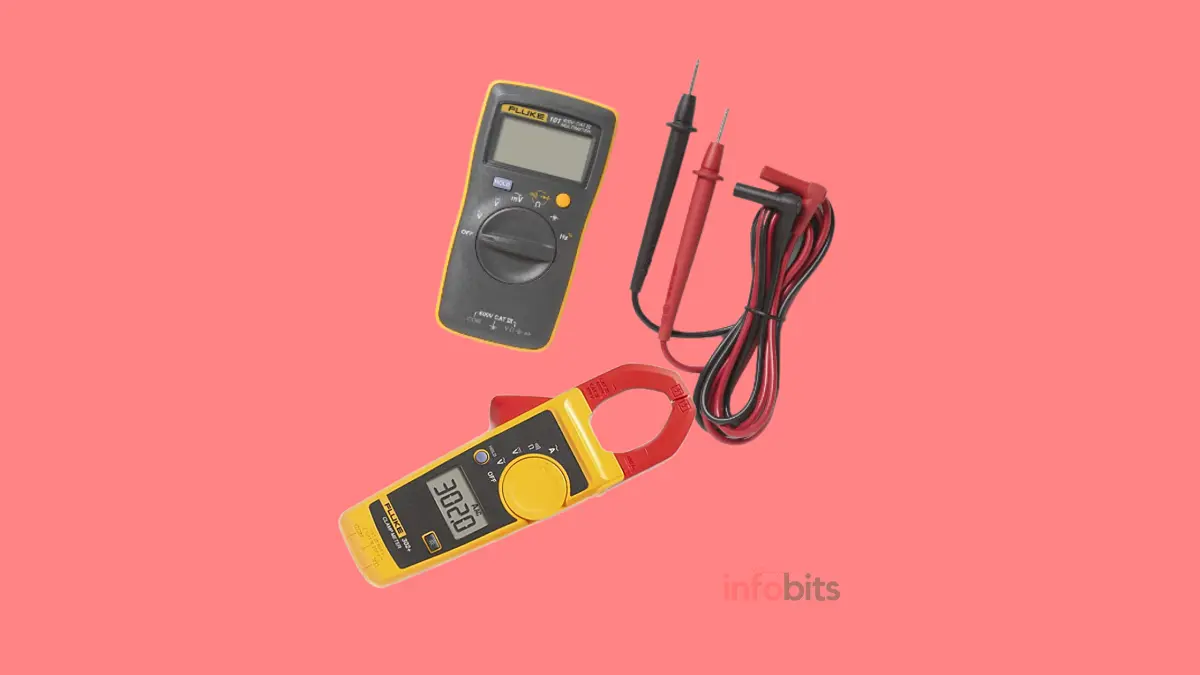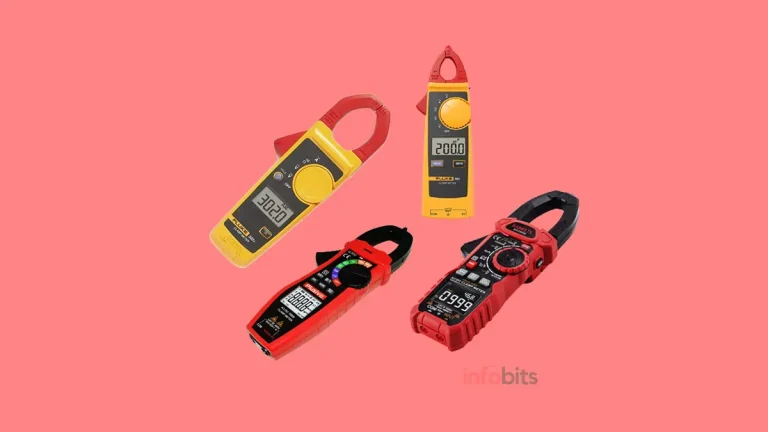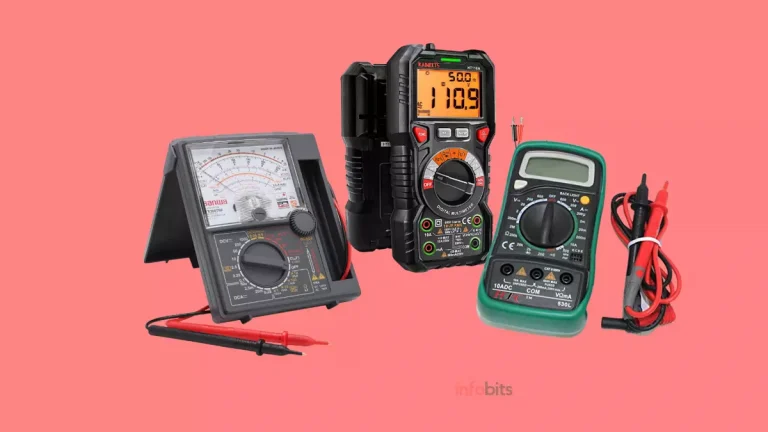Clamp Meter vs Multimeter: Main Differences and Which Is Better?
Clamp meters and multimeters are two commonly used instruments for measuring and testing electrical quantities, including voltage, current, and resistance.
Depending on their use, both are essential instruments for electricians, engineers, and technicians. Choosing the correct apparatus for your task might be difficult, especially if you are unfamiliar with the distinctions between the two.
However, in layman’s terms, a multimeter is used to measure low-rating current, voltage, resistance, continuity, and so on, whereas a clamp meter is intended to measure high currents with the option of measuring other electrical characteristics.
In this post, we’ll look into clamp meters and multimeters in further detail, compare their features, and help you determine which instrument is best for your requirements.
What is a Multimeter?
A volt-ohm meter (VOM), often known as a multimeter, is a flexible measuring device used to test and measure electrical parameters.
A multimeter, as the name indicates, is a device that combines many measurement devices into a single unit.A simple multimeter comprises a DC voltmeter, an AC voltmeter, a DC ammeter, an AC ammeter, and an ohmmeter.
Most people in the electrical or electronic industries are probably familiar with this tool.
Voltage, current, and resistance are the most common measurements, although some models can additionally measure capacitance, transistor gain, frequency, temperature, and other variables.
It is a handy instrument for checking electrical circuits since it can detect AC and DC voltage and current.
It is made up of three major parts: a display or reading dial, a selection switch, and probes. The measurement values are displayed on the display, and the selector switch is used to select the electrical parameter being monitored.
A multimeter is used to measure or test a circuit or component by attaching two probes to it. A digital or analogue readout then displays the measured parameter.
Some multimeters additionally have functions like data logging, auto-ranging, and auto shut-off. Multimeters are used for testing electronic devices and electrical components such as batteries, fuses, and switches.
Electricians, technicians, and hobbyists who deal with electrical or electronic circuits rely on them.
Multimeters are classified into two varieties depending on their design, measuring technique, and display: analogue and digital.
Analog multimeters display the measurement with a needle, whereas digital multimeters display the measurement on an LCD screen.
An analogue multimeter is a multimeter that employs a moving coil meter. It comprises an analogue display that indicates the level of the parameter under measurement by the deflection of a pointer.
A digital multimeter (DMM) allows you to measure in milliunits like millivolts, milliamps, and milliohms at a high resolution. It can also measure current up to 20 amps, depending on the type.
A plug-in clamp attachment to a digital multimeter is available in some models, allowing it to measure higher currents.
In general, the multimeter is one of the most significant tools for measurement that electricians and technicians use to diagnose electrical or electronic devices or circuits.
What is a Clamp Meter?
A clamp meter, also known as a current clamp or amp meter, is a specialized instrument for measuring the current flowing through a conductor without separating or disrupting it.
A clamp meter, unlike a multimeter, does not require direct contact with the circuit being measured.
In comparison to a multimeter, current measurement using a clamp meter is safer and more convenient in live circuits since it does not require the operator to break the circuit.
The jaw of a clamp meter may just be opened and clamped around the conductor being measured.
The secondary current produced by the current transformer is then measured in proportion to the primary current flowing through the conductor, and the current is shown on a digital or analogue readout.
An appropriate current transformer is positioned in the clamp’s jaws, which may be opened and closed around the conductor.
Clamp meters are often used to measure high-current circuits, such as those found in industrial equipment, power distribution systems, and powerful motors.
It normally measures to the nearest tenth or hundredth of a unit rather than in milliunits, as a multimeter may.
They are convenient for measuring current in tight or congested locations where a direct connection would be impossible or dangerous. Clamp meters are useful devices for electricians and technicians since they can measure both AC and DC currents.
Other electrical variables, such as voltage, resistance, and frequency, can also be measured using clamp meters. Some clamp meters allow you to measure the power supply’s phase shift and waveform.
In practice, several clamp meter models are available that can make a range of electrical measurements; nonetheless, the primary purpose of a clamp meter is to measure electric current.
Electrical faults can be diagnosed using clamp meters. If an electrical circuit fails, the clamp meter may be used to determine the current flowing through the wires. This might aid in locating the troublesome spot.
Clamp meters can also be used to measure an appliance’s load. This is a critical parameter for determining an appliance’s power usage.
You can assess an appliance’s efficiency by measuring its load. Some clamp meters have sophisticated capabilities, such as power quality analysis.
This may be used to detect problems with power quality such as harmonics, voltage swings, and power factors.
By detecting these problems, you can take corrective action to guarantee the proper operation of your electrical system.
Clamp Meter Vs. Multimeter: Usage Instances
Both of these devices, as explained in the preceding paragraphs, are used to measure various electrical properties such as voltage, current, resistance, and continuity.
While multimeters may measure a variety of electrical values, clamp meters are especially intended to detect alternating or direct current (AC or DC).
Previously, electricians measured current with multimeter test probes rather than clamps.
But a clamp meter allows you to measure current without interrupting the circuit and obtain a readout.
When doing electrical troubleshooting, it is sometimes necessary to use two meters, one to measure electrical current and one to monitor voltage.
In such cases, a clamp meter is the most adaptable and useful diagnostic tool. Meanwhile, industrial troubleshooters benefit from a separate clamp and digital multimeter.
Many technicians find it more cost-effective to purchase one high-quality instrument intended primarily for voltage (a DMM) and another piece of equipment designed largely for current (a clamp meter).
The best test equipment combination depends on the troubleshooting or testing scenario you’re working on and the measurements you want to take.
Multimeters and clamp meters are both necessary instruments for anyone who works with electrical systems.
While multimeters are more flexible and may measure a variety of electrical properties, clamp meters are especially intended to monitor current.
A multimeter is an appropriate equipment for low-voltage and low-current troubleshooting, testing, and measuring. However, in a high-voltage, high-current situation, a clamp meter is a far more appropriate and safe measurement tool.
Understanding the many applications of these tools allows you to select the best tool for the job and guarantee the safe and efficient operation of your electrical systems.
Related: Best Clamp Meters in India: How to Select a Good Clamp Meter
Clamp Meter Vs Multimeter: Key Differences
While both clamp meters and multimeters are used to measure electrical characteristics, they have important distinctions that make them ideal for various purposes.
| Details | Clamp Meter | Multimeter |
|---|---|---|
| Application | Specifically used for measuring high AC or DC High-end clamp meters have multimeter functions to measure other parameters. | Can be used for almost all the measurements of all the electrical and electronic parameters. However, it cannot be used for high-current measurements. |
| Usage Method | Has a sensing jaw that identifies and measures the current in the circuit needed to break the circuit conductor. | Measures the electrical quantities by connecting the problem in parallel or series to the circuit. We need to break the circuit for current measurement. |
| Accuracy | Accuracy is lower as compared to a multimeter. | A high degree of precision and accuracy |
| Safety | It is safer to use as there is no direct contact with the electrical circuit. | There is a risk to using a multimeter on live circuits. |
| Cost | A good clamp meter is costlier than a multimeter. | A decent multimeter for normal use is available at an affordable cost. |
These are the primary elements to consider when choosing a multimeter or clamp meter for your task.
a) Definition:
A multimeter is a multifunctional piece of electrical measurement equipment that can measure current, voltage, resistance, continuity, and other electrical quantities.
A clamp meter is a portable electrical measurement device used to measure the electric current in a circuit.
b) Method of use:
A multimeter is made up of two contact wires called probes that are placed directly on the circuit being measured.
The clamp meter has a clamp at one end that works as a sensor to measure the current in the wire around which it is clamped.
c) Function:
A multimeter can be used to examine and troubleshoot electrical or electronic devices and circuits with low voltage and low current. It may be used as a voltmeter, an ammeter, or an ohmmeter.
A clamp meter’s primary function is to measure the electric current in high-current circuits without making direct contact with the circuit.
Because the multimeter is connected in series within the circuit, we must first break the circuit to measure the current. However, there is no need to interrupt the circuit to measure with a clamp meter.
d) Accuracy:
In comparison to the clamp meter, the multimeter has a higher level of precision. This is especially true when measuring voltage and resistance.
The clamp meter has lower precision than the multimeter. This is because multimeters direct contact with the measured circuit, whereas clamp meters employ a current transformer to detect the current flowing through the wire.
The size and form of the conductor being measured can also impact the accuracy of a clamp meter.
e) Safety:
The probes on the multimeter are directly linked to the circuit, which might be dangerous if the circuit is live; therefore, it is not as safe as a clamp meter.
The clamp meter is safer to use since it does not make direct contact with the circuit, lowering the risk of electric shock, especially when measuring high-current circuits.
f) Usage scenario:
The multimeter is ideally suited for electrical operations when a range of tests with exact results are required.
A clamp meter is best suited for broad current measurements with little precision.
g) Cost:
Because they are more economical and commonly accessible, multimeters are less costly than clamp meters.
Because of this, the multimeter is a superior choice for technicians or amateurs of all budgets.
A clamp meter is more expensive, especially high-end versions with extensive capabilities.
Clamp meters are specialist equipment developed for measuring large currents, and measuring the current passing through the conductor requires a more accurate current transformer.
h) Measurement Range:
The measuring range of clamp meters and multimeters is one of the primary distinctions. Multimeters often provide a larger range of electrical parameter measurements than clamp meters, except in current measurement.
A multimeter, for example, can typically measure voltage up to 1000 volts and current up to 20 amps. In contrast, an ordinary clamp meter can typically measure current up to 2000 amps but may not be able to measure the voltage at all, even though some extremely expensive models have all multimeter functionalities.
i) Ease of Use:
Clamp meters are often more user-friendly than multimeters, especially for measuring high-current circuits.
This is because they can measure current without having to separate the circuit, which may be difficult and time-consuming with a multimeter.
Multimeters, on the other hand, are more flexible and may be used to measure a broader range of electrical properties. They are also easier for novices to operate since they have fewer buttons and settings than clamp meters.
Clamp Meter Vs. Multimeter: Which Instrument is Right for You?
Let’s take a deeper look at which instrument is best for you now that we’ve evaluated the different features of clamp meters and multimeters.
A multimeter is the best choice if you’re a hobbyist or DIY enthusiast who works with low- to medium-current circuits, such as those found in home appliances or automotive systems.
Multimeters are more versatile and less expensive than clamp meters, making them an excellent choice for novices or those on a tight budget.
Look for a multimeter that can measure the parameters you want, such as voltage, current, and resistance.
Consider the measurement range and precision, as well as options like data logging, auto-ranging, and auto shut-off.
We already have an extensive article that describes what factors to consider when choosing a decent multimeter and has discovered some of the top multimeters available in India.
A clamp meter is a preferable choice if you typically work with high-current circuits, such as those found in industrial equipment, power distribution systems, or powerful motors.
Clamp meters were specifically built to safely and precisely measure high-current circuits, making them an indispensable tool for electricians, technicians, and engineers.
Conclusion
Finally, clamp meters and multimeters are necessary instruments for measuring electrical properties.
They are, however, built for diverse purposes and have distinct features and benefits.
Consider the sort of circuits you work with, your level of experience, and your budget when deciding between a clamp meter and a multimeter.
You can operate securely and accurately by selecting the right instruments for your needs, allowing you to get the most out of your measuring or troubleshooting duties.
Hope this multimeter vs. clamp meter comparison guide is beneficial to you and please share it with your relatives and friends who want to know these things.
Also, don’t forget to follow our Facebook and Twitter pages for regular updates.
Subscribe to our free newsletter so that you will get regular updates directly in your Email.
Disclosure: We will receive an affiliate commission on some, but not all, of the items or services we mention in this post if you follow our links to a retailer’s website and make a purchase. This does not affect your price.




